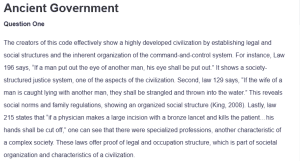Ancient Government
Question One
The creators of this code effectively show a highly developed civilization by establishing legal and social structures and the inherent organization of the command-and-control system. For instance, Law 196 says, “If a man put out the eye of another man, his eye shall be put out.” It shows a society-structured justice system, one of the aspects of the civilization. Second, law 129 says, “If the wife of a man is caught lying with another man, they shall be strangled and thrown into the water.” This reveals social norms and family regulations, showing an organized social structure (King, 2008). Lastly, law 215 states that “if a physician makes a large incision with a bronze lancet and kills the patient…his hands shall be cut off,” one can see that there were specialized professions, another characteristic of a complex society. These laws offer proof of legal and occupation structure, which is part of societal organization and characteristics of a civilization.
Question Two
Both Sargon of Akkad and Cyrus the Great justified their conquests by invoking divine favor, but they did so in different ways. Sargon emphasized his military prowess and dominance over other city-states, declaring himself the land’s ruler through force, as his inscription shows: “He conquered Uruk, destroyed its walls, and defeated the people of Uruk” (Royal inscriptions of lugalzagesi andsargon 1 tohru maeda *, n.d.). His victories were depicted as a sign of divine approval, but his focus remained on his capability as a military leader.
Moreover, Cyrus the Great painted his campaign as freeing the people. In the Cyrus Cylinder, he says that Marduk, the chief god, anointed him to “shepherd with justice and righteousness” and describes himself as liberating the people without forcefully conquering Babylon (Cyrus Cylinder Translation – Livius, 2017). While Sargon used force to support authority, Cyrus stressed good government and religious regeneration as the purposes for the conquests as a concern for the subject population. Moreover, to make sure that his newly dominated people accepted him, he made efforts to legitimize in the eyes of local gods, obeying the local customs and religions of the countries he conquered to gain the approval of his new subjects. This was unlike Sargon’s approach, which always emphasized military domination, culminating in the oppression of indigenous people and not their assimilation.
Question Three
In the first book, Genesis, the God of the Old Testament seems more similar to the God described in the Babylonian Hymn than in the Egyptian Hymn. In Genesis, God is depicted as a singular, all-powerful being who creates the universe, saying, “In the beginning, God created the heavens and the earth” Genesis 1:1. This portrayal aligns with the Babylonian Hymn, which praises a supreme deity, Marduk, for his role in creating order out of chaos: “Marduk, the great lord established an order.” Both deities are creators and rulers of all things, exercising power over the cosmos, unlike the Egyptian gods, who are often more associated with specific domains or natural forces.
Further, the God of the Old Testament also shares some traits with the Egyptian Hymn’s depiction of divinity, particularly in His intimate involvement with human affairs. In the Egyptian Hymn, the god Amun-Re is praised for being close to his people: “You are Amun, who comes at the cry of the poor” (BICKEL, 2024). Similarly, in the Old Testament, God shows personal care for humanity, creating Adam and Eve and providing for their needs in the Garden of Eden (Balogh, 2022). While both Babylonian and Egyptian texts reflect powerful deities, the personal, compassionate aspects of the Hebrew God find resonance with the Egyptian Hymn’s portrayal of a god intimately involved with human life.
References
Balogh, A. L. (2022). Myth, Meaning, and the Work of Life: Enuma Elish and the Garden of Eden (Genesis 2:4–3:24) on the Value of Human Labor and Memory. Religions, 13(8), 703. https://doi.org/10.3390/rel13080703
BICKEL, S. (2024). Kings as Gods in the New Kingdom. Orient, 59(0), 37–57. https://doi.org/10.5356/orient.59.37
Cyrus Cylinder Translation – Livius. (2017). Livius.org. https://www.livius.org/sources/content/cyrus-cylinder/cyrus-cylinder-translation/
King, L. W. (2008). The Avalon Project: Code of Hammurabi. Yale.edu; Lillian Goldman Law Library. https://avalon.law.yale.edu/ancient/hamframe.asp
ROYAL INSCRIPTIONS OF LUGALZAGESI ANDSARGON 1 Tohru MAEDA *. (n.d.). https://www.jstage.jst.go.jp/article/orient/40/0/40_3/_pdf/-char/en
ORDER A PLAGIARISM-FREE PAPER HERE
We’ll write everything from scratch
Question
Your first assignment consists of three questions worth 5 points each. Each questions will require you to consult primary source readings posted to Canvas. Anytime that you quote or paraphrase from one of the sources, I want you to provide a citation in whatever format you feel comfortable with. This can be something simple like (Genesis 2:1). Direct quotes are preferred, please let me know if you have any questions.
- Consider the law code posted to Module 1 in Canvas. How do we know that the people who created this code met our textbook definition of civilization? Your essay must cite at least THREE separate laws from the code and explain how they present evidence of at least THREE characteristics of civilization.
- Consider the inscriptions of two victorious emperors, Sargon of Akkad (c. 2300 BCE) and Cyrus the Great (c. 550 BCE), that are posted to canvas. Compare and contrast the way that these two rulers explained and justified their conquest over other peoples. You must quote directly from both sources in your answer.
- Modules 1 and 2 contain the following religious texts: A Babylonian Hymn, An Egyptian Hymn, and the first book of the Hebrew Bible (The Old Testament). After reading these three sources, do you think the God of the Old Testament seems more like the God described in the Babylonian Hymn or in the Egyptian Hymn? Please use direct quotes or evidence from all three sources.
Ancient Government
LINKS OF READINGS
- https://quod.lib.umich.edu/
cgi/k/kjv/kjv-idx?type=DIV1& byte=1477 - https://www.ucl.ac.uk/museums-
static/digitalegypt/amarna/ belief.html - https://www.soas.ac.uk/baplar/
recordings/poem-righteous- sufferer-ludlul-bel-nemeqi- tablet-ii-entire-tablet-read- karl-hecker - https://www.livius.org/
sources/content/cyrus- cylinder/cyrus-cylinder- translation/ - https://www.jstage.jst.go.jp/
article/orient/40/0/40_3/_pdf/ -char/en - https://avalon.law.yale.edu/
ancient/hamframe.asp


